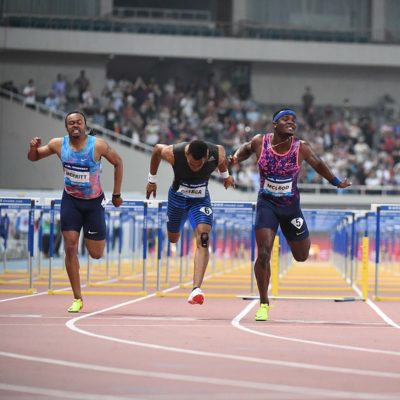May 15, 2017
Omar McLeod’s performances at the Olympic Games last year and in the early part of the outdoor season this year has got him turning heads. It’s not even June yet, and McLeod has already run sub-13.10 twice, and seems poised to go under 13.00 on a regular basis once the summer gets here. Whenever a hurdler is on a roll like McLeod has been on for the past two years or so, you have to ask, What is he doing to run so fast?
In the case of McLeod, because he is so fast with his sub 10.00 100m speed, the answer seems to be simple: his speed can carry him through mistakes, so even if he doesn’t have perfect technique, he’ll run in the 13.0 range regularly with that kind of speed.
While there may be some credence to that viewpoint, I would argue that it represents an oversimplification. McLeod is a very good hurdler. You can’t run hurdles the way he does on speed alone. In a lot of ways, what he is doing is nothing short of phenomenal. He’s only 5’10”; he’s supposed to be smacking hurdles right and left. He’s supposed to be too short for this race. He’s supposed to be breaking down in the second half of races. But he’s not. He’s also at a disadvantage because he’s eight-stepping to the first hurdle while all of his opponents are seven-stepping. But that’s proving not to matter at all. Why? How is McLeod able to run over these 42-inch barriers so quickly and efficiently? Here are a few things I’ve noticed:
1) Though he takes eight steps to the first hurdle, taking that one extra stride in comparison to his opponents does not create a disadvantage for someone his height. For optimal take-off distance to hurdle one, the eight-step approach allows him to have an ideal cut-step, and therefore a very explosive attack of the first hurdle. Also, he has very fast reaction time to the starter’s gun, and he gets out of the blocks very quickly. He puts pressure on his opponents from the outset of the race to come and catch him. And in the hurdles that is especially important, as it can get the other hurdlers out of their rhythm.
2) McLeod did have trouble in a couple races last year with hitting hurdles – a problem, as I mentioned before, that is to be expected among smaller hurdlers. But he seems to have addressed it and fixed it. In both of his outdoor races thus far this year – at the Drake Relays and at the Diamond League meet in Shanghai – he has run very clean races. The reason, as it seems to me, is that he has compensated in a way that smaller hurdlers need to: when he takes off into hurdles, he gets a good push off his back leg that raises his hips enough that he becomes, in essence, “taller.” Also, as he is pushing off the back leg, he is also pushing the hips forward. So the hips, in an optical-illusion sort of way, are rolling upward and forward at the same time. With this hip height, he is able to avoid contact with the crossbar. By pushing the hips forward, he maintains forward momentum and speed off the hurdle.
3) I’m assuming that he is super-strong in his abdominal and core muscles. He doesn’t lean as deeply as you would think a smaller hurdler would need to. To negotiate the barriers without a deep lean, he is getting great hip rotation, his adductors and abductors are keeping him stable so that he doesn’t have any balance issues during hurdle clearance. He opens the groin of his trail leg very widely while also raising the knee of the trail leg very high as he drives it to the front. That is very difficult to do, and requires exceptional flexibility and strength. Usually, hurdlers who really flatten out the trail leg aren’t able to get the knee up that high when driving it to the front. And that is huge when it comes to sprinting off the hurdle. The high knee of the trail leg ensures a very powerful first stride and increased momentum heading into the next hurdle.
4) Along the same lines as above, McLeod does something that all great hurdlers do: he explodes into hurdle position instantly after leaving the track. That ability to explode into position is a trait of all the best hurdlers, regardless of their style and regardless of whether or not they have other weaknesses.
5) This one may seem simple, but it’s important: McLeod has very low hurdle clearance. In the Drake race, you can see how much lower his clearance is compared to Aries Merritt in the lane next to him. McLeod “skims” the hurdles the way old-school hurdlers were taught to do. Smaller hurdlers have less margin for error than taller hurdlers. For McLeod, he has to walk that fine line between skimming the hurdles and hitting the hurdles. He must skim them, but he can’t hit them. The fact that he has been able to walk that fine line so well has much to do with why he has been running so fast.
6) Ironically, being smaller does give him one advantage: it gives him more room to sprint between the hurdles than taller hurdlers have. So although he can’t use all of that 9.99 100 meter speed between the hurdles, he can use more of it than, say, a Terrence Trammell could have back in the day.
Take a close look at the YouTube videos below – the first of the Drake race, the second of the Shanghai Race – to get a visual of the things I discussed in this post.

